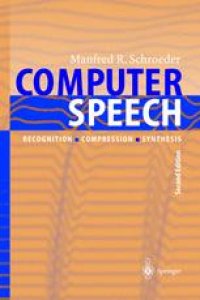
Ebook: Computer Speech: Recognition, Compression, Synthesis
- Tags: Physics general, Acoustics, User Interfaces and Human Computer Interaction, Language Translation and Linguistics, Communications Engineering Networks
- Series: Springer Series in Information Sciences 35
- Year: 2004
- Publisher: Springer-Verlag Berlin Heidelberg
- Edition: 2
- Language: English
- pdf
The first edition having been sold out, gives me a welcome opportunity to augment this volume by some recent applications of speech research. A new chapter, by Holger Quast, treats speech dialogue systems and natural lan guage processing. Dictation programs for word processors, voice dialing for mobile phones, and dialogue systems for air travel reservations, automated banking, and translation over the telephone are at the forefront of human-machine inter faces. Spoken language dialogue systems are also invaluable for the physically handicapped. For researchers new to the field, the new chapter (pp. 67-106) provides an overview of fundamental linguistic concepts from phonetics, morphology, syntax, semantics and pragmatics, gramm ars and knowedge representation. Symbolic methodology, such as Norman Chomsky's traditional hierarchy of formal languages is layed out as are statistical approaches to analyze text. Proven tools of language processing are covered in detail, including finite state automata, Zipf's law, trees annd parsers. The second part of the new chapter introduces the building blocks of state-of-the-art dialogue systems.
This new edition of Computer Speech is an introduction to multimedia speech applications that is also suitable for nonspecialists. New material treats such contemporary subjects as automatic speech recognition and speaker verification for banking by computer and privileged (medical, military, diplomatic) information and control access. The book also focuses on speech and audio compression for mobile communication and the Internet. The importance of subjective quality criteria is stressed. A brief history of speech research summarizes the development from the first talking machines in 18th-century Europe to modern x-ray methods of articulatory analysis. The book also contains introductions to human monaural and binaural hearing, and the basic concepts of signal analysis. Beyond speech processing, this revised and extended new edition of Computer Speech gives an overview of natural language technology and presents the nuts and bolts of state-of-the-art speech dialogue systems.
This new edition of Computer Speech is an introduction to multimedia speech applications that is also suitable for nonspecialists. New material treats such contemporary subjects as automatic speech recognition and speaker verification for banking by computer and privileged (medical, military, diplomatic) information and control access. The book also focuses on speech and audio compression for mobile communication and the Internet. The importance of subjective quality criteria is stressed. A brief history of speech research summarizes the development from the first talking machines in 18th-century Europe to modern x-ray methods of articulatory analysis. The book also contains introductions to human monaural and binaural hearing, and the basic concepts of signal analysis. Beyond speech processing, this revised and extended new edition of Computer Speech gives an overview of natural language technology and presents the nuts and bolts of state-of-the-art speech dialogue systems.
Content:
Front Matter....Pages I-XXXIV
Introduction....Pages 1-21
A Brief History of Speech....Pages 23-40
Speech Recognition and Speaker Identification....Pages 41-65
Speech Dialogue Systems and Natural Language Processing....Pages 67-106
Speech Compression....Pages 107-127
Speech Synthesis....Pages 129-134
Speech Production....Pages 135-147
The Speech Signal....Pages 149-152
Hearing....Pages 153-177
Binaural Hearing — Listening with Both Ears....Pages 179-206
Basic Signal Concepts....Pages 207-245
Acoustic Theory and Modeling of the Vocal Tract....Pages 247-268
Direct Relations Between Cepstrum and Predictor Coefficients....Pages 269-277
Back Matter....Pages 279-381
This new edition of Computer Speech is an introduction to multimedia speech applications that is also suitable for nonspecialists. New material treats such contemporary subjects as automatic speech recognition and speaker verification for banking by computer and privileged (medical, military, diplomatic) information and control access. The book also focuses on speech and audio compression for mobile communication and the Internet. The importance of subjective quality criteria is stressed. A brief history of speech research summarizes the development from the first talking machines in 18th-century Europe to modern x-ray methods of articulatory analysis. The book also contains introductions to human monaural and binaural hearing, and the basic concepts of signal analysis. Beyond speech processing, this revised and extended new edition of Computer Speech gives an overview of natural language technology and presents the nuts and bolts of state-of-the-art speech dialogue systems.
Content:
Front Matter....Pages I-XXXIV
Introduction....Pages 1-21
A Brief History of Speech....Pages 23-40
Speech Recognition and Speaker Identification....Pages 41-65
Speech Dialogue Systems and Natural Language Processing....Pages 67-106
Speech Compression....Pages 107-127
Speech Synthesis....Pages 129-134
Speech Production....Pages 135-147
The Speech Signal....Pages 149-152
Hearing....Pages 153-177
Binaural Hearing — Listening with Both Ears....Pages 179-206
Basic Signal Concepts....Pages 207-245
Acoustic Theory and Modeling of the Vocal Tract....Pages 247-268
Direct Relations Between Cepstrum and Predictor Coefficients....Pages 269-277
Back Matter....Pages 279-381
....